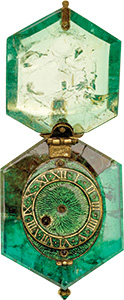|
Legacy
A Jewelry Time Capsule
A rare look at jewelry from the seventeenth century is on view at the Museum of London
By Phyllis Schiller

|
|
Watch set in a single Colombian crystal, circa 1600.
Photo © Museum of London.
|
The Cheapside Hoard: London’s Lost Jewels”
is a modern-day treasure trove of approximately 500 items that includes unparalleled examples of Elizabethan and Early Stuart jewelry. They range from rings, necklaces and brooches to other
adornments such as bejeweled buttons and gem-encrusted scent bottles. The collection is being shown in its entirety for the first time this fall at the Museum of London.
The exhibition examines the origins of the jewelry, placing it in context of the fashions of the day and the jewelry trade at the time, as well as revealing details that have helped pinpoint the origins of the dazzling pieces.
The cache was uncovered in 1912 under a cellar in the Cheapside area of London. Just who secreted the precious “hoard” and why has puzzled scholars since the discovery.
Two major facts helped narrow the period when the jewels were hidden away. Evidence at the site confirmed the building had been damaged in the Great Fire of London,
which occurred in 1666. Examination of one of the pieces, a cornelian intaglio, an engraved gemstone, showed that it bore the heraldic badge of the first and only Viscount
Stafford (1612-1680), who was granted the peerage in 1640, providing a more precise time frame of 1640 to 1666. Moreover, Stafford was known to be an avid collector of the type of gems and antiquities found at Cheapside.
London’s Cheapside neighborhood in the seventeenth century was a thriving commercial area where shops offered luxury goods and jewelers and goldsmiths plied their trade. In fact, says Hazel Forsyth, the exhibition curator,
Londoners of the period were “discerning jewelry
buyers. A huge variety of gem material was available and the skills of the stonecutters, setters, mounters and
enamelers were of the highest order.”
The settings of the jewelry, explains Forsyth, “reflecting the new fashions of the early-seventeenth century, were reduced to a skeletal frame, allowing the gem material to take pride of place. As a result, the quality of the gemstones and the skills of the cutter are paramount. The jewelry market was sophisticated and highly complex. Each piece required a high level of craft, skill and ingenuity and some of those techniques used have now been lost.”
The Cheapside Hoard also sheds light on London’s extensive trade networks across the globe during the
sixteenth and seventeenth century that provided jewelers with a wealth of materials to use in their craft. “The Hoard contains,” Forsyth goes on to say, “gem material from both the Old World and the New World. It represents a coming together of emeralds from Colombia, heliodors from
Brazil, chrysoberyl from Mexico, pearls from the Persian Gulf, rubies and diamonds from Burma and India, nephrite jade from China, lapis lazuli from Afghanistan, peridot from the Red Sea, moonstones and spinels from Sri Lanka.” For example, a salamander brooch, circa sixteenth to seventeenth century, is adorned with emeralds from Colombia, diamonds from India and European enameling.
Among the many items are specific types of jewelry that point to their popularity in the seventeenth century, including a variety of pendants, which would have been worn suspended from ears, hair and clothing, or fastened onto other jewels, and a selection of finely wrought gold and enameled chains of different lengths. The Cheapside Hoard also includes a large number of rings, some with a single faceted stone and others with clusters of cabochons.
Helping to put the jewelry into context, the exhibition includes portraits and accessories — hat, purse, embroidered jacket and skirt and gloves — showing the fashions of the day the jewelry would have been worn with. There is also a reconstruction of a seventeenth-century goldsmith-jewelers
workshop, and even a “sensory” installation that includes a
fragrance created by master perfumer Roja Dove re-creating perfume worn in Elizabethan and Early Stuart London.
Along with the more everyday pieces, there are some dazzling examples of a jeweler’s artistry, including a gilt brass verge watch, the only signed piece in the exhibit, which bears
the name “G Ferlite” (of Geneva), who practiced his trade
between 1590 and 1635; a sixteenth-century onyx cameo of Elizabeth I and a sardonyx cameo, circa second or third centuries BC, depicting a Ptolemaic queen — possibly Cleopatra — as the goddess Isis.
The most unique item, Forsyth points out, is a watch set in a case carved from an emerald crystal (pictured at right).“It is the only one of its kind in the world. The stones forming the case and lid are carved from emeralds from the Muzo mines in Colombia, which have been cut to house an early-seventeenth century timepiece with a translucent green enamel dial. The stones are of exceptional quality and emerald is a particularly difficult stone to cut. How did these stones reach London? There are many possible answers, and that is what is so interesting.”
Visitors will see a breathtakingly beautiful collection of jewelry, Forsyth concludes, “which is unparalleled anywhere else in the world. The exhibition explores the mysteries surrounding the Hoard, and the wider landscape of Elizabethan and Early Stuart London. It also looks at the clandestine world of the goldsmith jeweler and offers new evidence about the individuals and communities involved in the trade, their creative talents, craft skills and manufacturing techniques. I hope it will open people’s eyes to a ‘new world’ of intrigue and wonder.”
“The Cheapside Hoard: London’s Lost Jewels,” Museum of London, sponsored by Fabergé and Gemfields, is on exhibit from October 11, 2013, through April 27, 2014. Article from the Rapaport Magazine - September 2013. To subscribe click here.
|
|